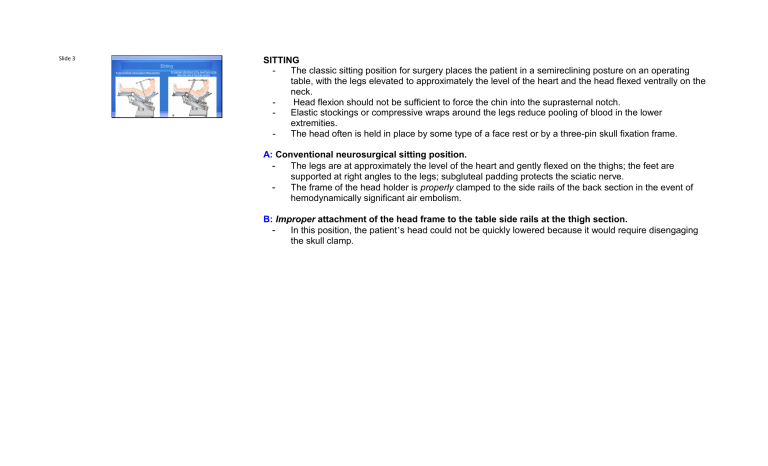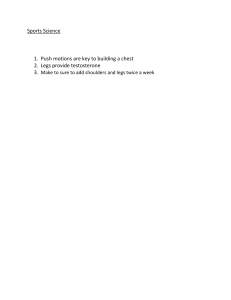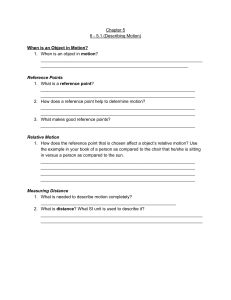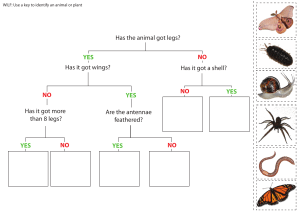
Slide 3 Sitting A: Conventional neurosurgical sitting position. B: Improper attachment of the head frame to the table side rails at the thigh section. SITTING The classic sitting position for surgery places the patient in a semireclining posture on an operating table, with the legs elevated to approximately the level of the heart and the head flexed ventrally on the neck. Head flexion should not be sufficient to force the chin into the suprasternal notch. Elastic stockings or compressive wraps around the legs reduce pooling of blood in the lower extremities. The head often is held in place by some type of a face rest or by a three-pin skull fixation frame. A: Conventional neurosurgical sitting position. The legs are at approximately the level of the heart and gently flexed on the thighs; the feet are supported at right angles to the legs; subgluteal padding protects the sciatic nerve. The frame of the head holder is properly clamped to the side rails of the back section in the event of hemodynamically significant air embolism. B: Improper attachment of the head frame to the table side rails at the thigh section. In this position, the patient’s head could not be quickly lowered because it would require disengaging the skull clamp. Supine - Tilted Head Up A: The legs are at approximately heart level and the gradient into the head is appreciable but slight. B: The flat table and foot rest are useful when a thyroidectomy is planned under regional anesthesia. Supine—Tilted Head Up A supine recumbent position with the head of the patient elevated is used for many operations involving the ventral and lateral aspects of the head and neck, and occasionally with the neck flexed, for transcranial access to the top of the brain. Its purpose is to improve access to the surgical target for the operating team as well as to drain blood and irrigation solutions away from the wound. The back section of the surgical table can be elevated as needed to produce a low sitting position (A) or the entire table can be rotated head-high with the patient’s extended legs supported by a foot rest (B). Although the degree of tilt typically is not great, small pressure gradients are created along the vascular axis that can pool blood in the lower extremities or entrain air in patulous vessels that are incised above the level of the heart. Figure Head-elevated positions often used for operations about the ventral and ventrolateral aspects of the head, face, neck, and cervical spine. A: The legs are at approximately heart level and the gradient into the head is appreciable but slight. B: The flat table and foot rest are useful when a thyroidectomy is planned under regional anesthesia. Supine - Tilted Head Up A: The lawn chair position for surgery around the shoulder joint. B: The upper torso is rotated toward the nonsurgical shoulder and supported with a firm roll or pad. For operations around the shoulder joint, the patient may be placed in a head-elevated semisupine position. The upper trunk typically is moved laterally until the raised surgical shoulder extends beyond the edge of the operating table. The torso is supported so that the hips are on the table, the surgical shoulder is off and above the table edge, and the head rests on either a pillow (A) or a headrest (B). Access is thereby provided to both the dorsal and ventral aspects of the shoulder girdle. The surgical arm remains on the front of the torso and is prepared and draped to be mobile in the surgical field. Figure 29-19 A: The lawn chair position for surgery around the shoulder joint. B: The upper torso is rotated toward the nonsurgical shoulder and supported with a firm roll or pad. Lateral - Tilted Head Up Park Bench Position Lateral—Tilted Head Up The lateral position with the head somewhat elevated, a means of access to occipitocervical lesions, has also been referred to as the park bench position. All the stabilizing requirements needed for the usual lateral position apply. The head may be held firmly in a three-pin skull fixation holder, which can be readjusted as needed during surgery, or supported by pillows or padding. Although the degree of head elevation used typically is less than 15 degrees, the position does not completely remove the threat of air embolization. The anesthesiologist has good access to the patient’s face and thorax for purposes of monitoring, manipulation, and resuscitation. Considerable attention should be directed to avoiding compression of neck veins, which can lead to an increase in intracranial pressure and to edema of the tongue.


